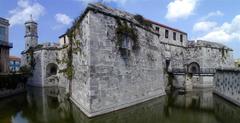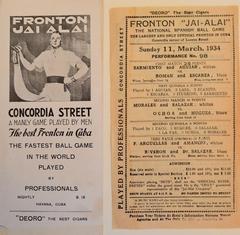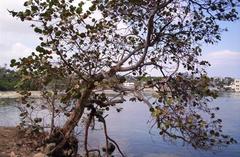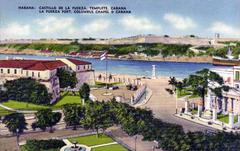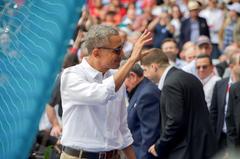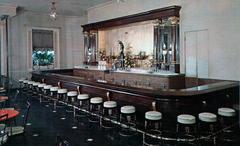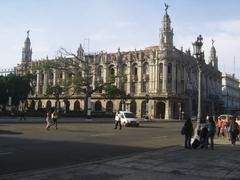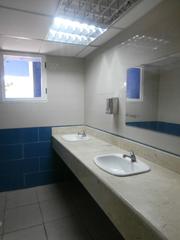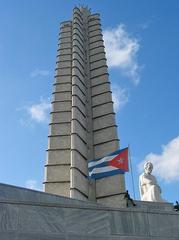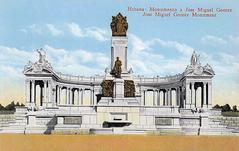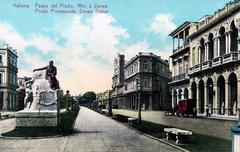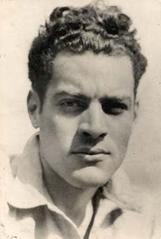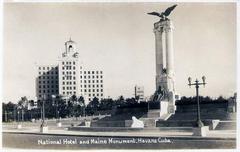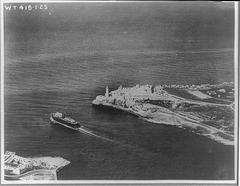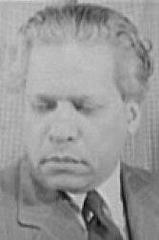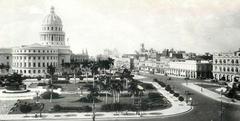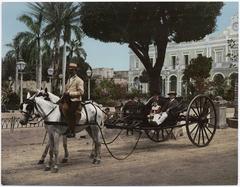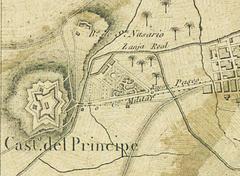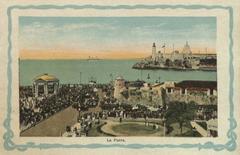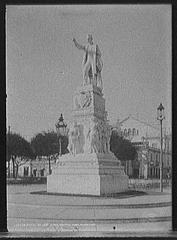
San Lázaro Tower: Visiting Hours, Tickets, and Historical Sites in Havana Province, Cuba
Date: 04/07/2025
Introduction
The San Lázaro Tower (Torreón de San Lázaro) is a prominent symbol of Havana’s colonial heritage and cultural identity. Originally constructed in 1665 under the direction of engineer Marcos Lucio, this cylindrical masonry tower was an essential part of Havana’s Spanish colonial fortification system, strategically placed to protect the city and its port from pirates and rival colonial forces (UNESCO; Epic Nomad Life; Official Havana Tourism Website). Its robust architecture and prime location along the Malecón near the historic Hospital de San Lázaro underscore both its military function and its integration into Havana’s urban and spiritual landscape.
Located in the culturally rich San Lázaro district, the tower is closely associated with Cuban religious traditions venerating Saint Lazarus—syncretized in Cuban Santería with Babalú Ayé, the orisha of healing and protection. The nearby Sanctuary of San Lázaro in Rincón, a renowned pilgrimage site, further highlights the depth of spiritual significance attached to the area (Ashepa Mi Cuba; Lonely Planet).
Today, the San Lázaro Tower opens its doors to visitors from 9:00 AM to 5:00 PM, generally free of charge. Occasional guided tours and its proximity to key Havana landmarks, like the Museum of the Revolution and the Monument to General Antonio Maceo, make it an essential stop for anyone exploring Havana’s layered history. While the historic structure presents some accessibility challenges, ongoing preservation efforts aim to maintain its status as a testament to Havana’s enduring spirit (Mapcarta; Translating Cuba).
This guide provides a comprehensive overview of the San Lázaro Tower, covering its history, architecture, visitor information, cultural context, and nearby attractions.
Table of Contents
- San Lázaro Tower History
- Architectural Features and Significance
- Visiting Information
- Visitor Experience and Nearby Attractions
- Preservation and Contemporary Context
- San Lázaro Tower as a Spiritual Landmark
- Frequently Asked Questions (FAQ)
- Travel Tips and Practical Information
- References
San Lázaro Tower History
Early Foundations and Colonial Context
Havana’s strategic location on Cuba’s northwestern coast made it a frequent target for pirates and colonial rivals throughout the 16th and 17th centuries. The Spanish Crown responded with an extensive program of fortification, culminating in a network of forts, walls, and watchtowers (UNESCO; Epic Nomad Life). The San Lázaro Tower was built as part of this defense system, providing surveillance and protection along the city’s expanding perimeter.
Construction and Military Role
The tower was constructed near the intersection of present-day San Lázaro and Galiano streets, a critical location for monitoring approaches from the west. Its main function was as a coastal watchpoint and artillery post, communicating via visual signals with larger fortresses to coordinate Havana’s defense (Mapcarta).
Urban Development and Changing Significance
As Havana expanded beyond its original walls, the area around the tower transformed into a lively urban district, Centro Habana. The tower’s historical importance persisted, serving as a physical reminder of the city’s colonial resilience and as part of a broader cultural landscape that includes prominent monuments and museums (Epic Nomad Life).
Cultural and Religious Associations
The San Lázaro district is deeply rooted in Cuban spiritual tradition. Saint Lazarus, or San Lázaro, is venerated as a miraculous healer and is syncretized in Santería with Babalú Ayé. Each December 17, thousands of devotees participate in a pilgrimage to the Sanctuary of San Lázaro in Rincón, reinforcing the district’s spiritual significance (Ashepa Mi Cuba).
Architectural Features and Significance
Exterior Structure and Materials
Built of thick masonry in 1665, the San Lázaro Tower is a classic example of 17th-century Spanish colonial military architecture. Its cylindrical form measures approximately 4.57 meters in diameter and 9.14 meters in height, designed for resilience against both the elements and potential attackers.
Defensive Features
The tower includes evenly spaced embrasures for observation and firing, a battlemented parapet with crenellations, and robust walls to support its military purpose.
Interior Layout
The ground floor was likely used for storing munitions, the intermediate level for observation, and the uppermost platform for signaling and defense.
Evolution and Urban Context
Originally set on the coast, urban expansion and the creation of the Malecón have shifted the tower’s position inland, now located within Parque Antonio Maceo. Restoration efforts have preserved its defining features despite urban pressures (UNESCO).
Visiting Information
Visiting Hours
- Open: Tuesday to Sunday, 9:00 AM – 5:00 PM
- Closed: Mondays and major Cuban public holidays
Tickets and Entry Fees
- Admission: Free of charge; donations for preservation are appreciated
Accessibility
- The tower’s original structure includes narrow stairs and uneven floors, limiting accessibility for those with mobility challenges. The surrounding park is wheelchair accessible.
Guided Tours and Special Events
- Occasional guided tours are available through local operators or the Havana tourism office.
- Special events and educational programs are sometimes hosted at the tower and surrounding park.
Getting There
- Located in Parque Antonio Maceo along the Malecón, the tower is accessible by taxi, public bus, or on foot from central Havana.
Visitor Experience and Nearby Attractions
Unique Features
- The tower’s circular architecture distinguishes it from other Havana fortifications.
- Informational plaques and (when available) guided tours provide historical context.
Photographic Opportunities
- The tower’s silhouette is striking at sunrise and sunset, with panoramic views of the Malecón and Havana’s coastline.
Nearby Attractions
- Museum of the Revolution
- Monument to General Antonio Maceo
- Centro Habana and Vedado neighborhoods
- Real Fábrica de Tabacos Partagás
- Teatro Tacón
These can be easily combined into a single day’s exploration.
Preservation and Contemporary Context
While Old Havana’s major monuments have seen significant restoration, the San Lázaro Tower—like many Centro Habana landmarks—faces ongoing challenges from neglect, urban development, and natural disasters (Translating Cuba). Despite setbacks, especially after events like Hurricane Ike in 2008, the tower remains a point of interest due to community efforts and its enduring historical presence.
Recent revitalization projects, especially around Havana’s 500th anniversary in 2019, have focused on infrastructure improvements and heritage preservation, although further attention is needed for sites like the San Lázaro Tower (NNOC).
San Lázaro Tower as a Spiritual Landmark
The Sanctuary and Chapel
The Santuario de San Lázaro in Rincón is a major spiritual destination, particularly for those seeking healing. The sanctuary houses a revered statue of Saint Lazarus, venerated by both Catholics and practitioners of Santería, where he is syncretized with the orisha Babalú Ayé (Ashepa Mi Cuba; Lonely Planet).
Pilgrimage and Rituals
Every December 17, thousands of Cubans participate in a pilgrimage to the sanctuary, fulfilling promises and seeking blessings. The event is an impressive display of Cuba’s cultural syncretism, blending Catholic and Afro-Cuban traditions.
Visitor Etiquette
- Dress modestly and maintain a respectful demeanor.
- Donations are welcomed, especially for maintenance and charitable activities.
Frequently Asked Questions (FAQ)
Q: What are the San Lázaro Tower visiting hours?
A: Tuesday–Sunday, 9:00 AM–5:00 PM. Closed Mondays and major holidays.
Q: Is there an entrance fee?
A: No; admission is free, but donations are encouraged.
Q: Are guided tours available?
A: Yes, though availability varies. Check with local tourism offices.
Q: Is the tower accessible for visitors with disabilities?
A: Accessibility is limited within the tower, but the surrounding park is accessible.
Q: Can I visit other historical sites nearby?
A: Yes; the tower is within walking distance of several major Havana attractions.
Q: How do I reach the San Lázaro Sanctuary in Rincón?
A: Best reached by taxi or organized tour from Havana. Public transport is limited (Lonely Planet).
Travel Tips and Practical Information
- Currency: Bring cash (CUP) for donations and purchases; credit cards are rarely accepted (Hostal San Lázaro 17).
- Language: Spanish is predominant; basic phrases or a translation app are helpful.
- Best time to visit: Mornings for cooler weather and fewer crowds.
- Health and safety: Facilities are basic; Havana offers the nearest comprehensive care.
- Visa: A Tourist Card (Visa) is required for entry into Cuba.
- Weather: December is mild; dress accordingly for the tropical climate.
References
- UNESCO World Heritage: Old Havana and its Fortifications
- Epic Nomad Life – Interesting Facts About Havana, Cuba
- Official Havana Tourism Website
- Mapcarta – San Lázaro Tower Location
- Translating Cuba – Urban Development and Preservation Challenges
- NNOC – Havana’s 500th Anniversary and Preservation Efforts
- Ashepa Mi Cuba – Cultural and Religious Significance of San Lázaro
- Lonely Planet – San Lázaro Sanctuary
- Hostal San Lázaro 17
- Ocean Posse – Old Havana and its Fortification System





